il scindapsus pictus is a plant belonging to the Araceae botanical family. It is very similar to the more famous one photos (epipremnum aureum)with which it is often confused, in fact it is commonly called silver pothos jew sempliċiment scindapsus. With its dark green leaves, with silver or light golden spots, the scindapsus pictus It is a very popular ornamental plant for houseplant enthusiasts, as it adds a touch of beauty and freshness to home interiors. In addition to its attractive appearance, this plant is also relatively easy to grow and requires little maintenance, making it an ideal choice for beginners or those who don’t have much time to devote to plant care.
In this article, we’ll explore the different nuances of hair care scindapsus pictus at home, providing useful advice on light, watering, soil and much more.
What are the botanical characteristics of the scindapsus pictus?
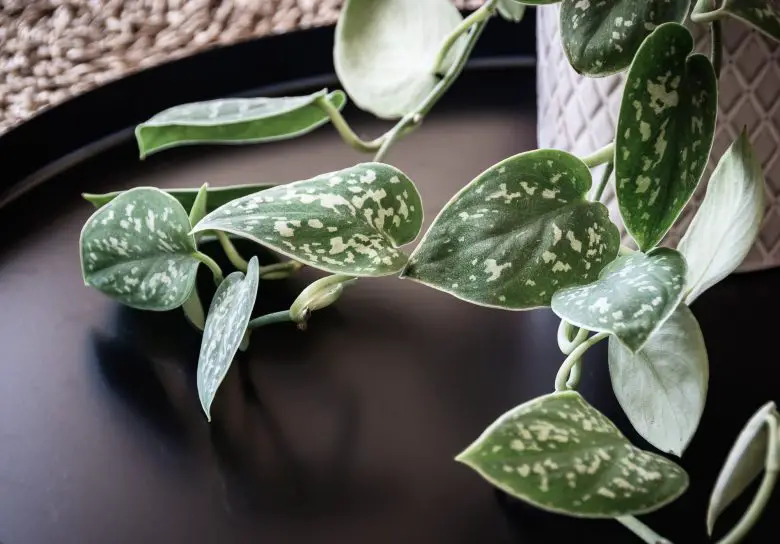
Il-pjanti tal-ġeneru Scindapsus they are native to the tropical forests of Southeast Asia, including countries such as Malaysia, Indonesia and Bangladesh. For this reason in the West the plant is commonly cultivated as an indoor ornamental plant. From a botanical point of view, in nature it is a climbing plant that can reach considerable heights and uses trees or other supports as a support. In the apartment its dimensions are smaller, but with adequate supports the stems or lianas can be extended for a few meters. Its leaves are large and heart-shaped, with an elongated, pointed shape at the end. The distinguishing feature of scindapsus is its dark green leaves that have silver or gold spots, giving them a satiny or marbled appearance.
il scindapsus pictus it is considered a fast growing plant and can develop long hanging vines. The plant tends to grow upwards until it finds a support to cling to, after which it begins to develop hanging vines. It can also develop aerial roots which allow it to cling to vertical surfaces such as walls or artificial supports.
This plant is known for its ability to purify the air, as it is able to absorb and filter some pollutants present in the air, thus helping to improve the quality of domestic environments. The scindapsus pictus can help reduce the levels of pollutants such as formaldehyde, benzene, toluene and other harmful volatile organic compounds. Its leaves are capable of absorbing such harmful substances through their pores. Subsequently, these substances are transformed and degraded within the plant itself.
X'inhuma l-varjetajiet ta ' scindapsus pictus fis-suq?
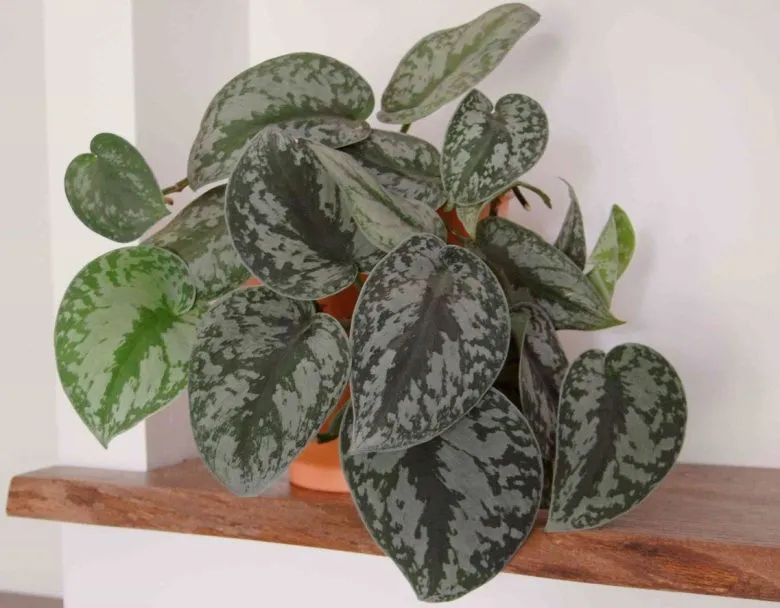
Scindapsus pictus Exotica
There are several commercial varieties of scindapsus pictus, each with its unique characteristics. Here are some of the most popular varieties:
- eżotiku: it is a very common and widely appreciated variety for its dark green leaves with silver or white spots. The white spots on the leaves are usually more pronounced than on the base variety. This variety is appreciated for its attractive and decorative appearance;
- Argyraeus: it is a variety similar to the “Exotica”, but with smaller white or silver spots distributed more evenly over the entire leaf. The leaves of this variety are thinner than and have a more delicate appearance;
- Silvery Ann: This variety has dark green leaves with a marked white vein running through the leaves. The white veining can vary in width and intensity, creating a distinctive contrast with the green color of the leaves. It is a highly appreciated variety for its elegant and refined appearance.
These are just some of the varieties scindapsus pictus available on the market. Each variety may have slight differences in leaf shape, spot size and color intensity. By choosing the variety that you like best, you can add a decorative and charming touch to your interior space.
How to take care of a plant photos silver fid-dar?
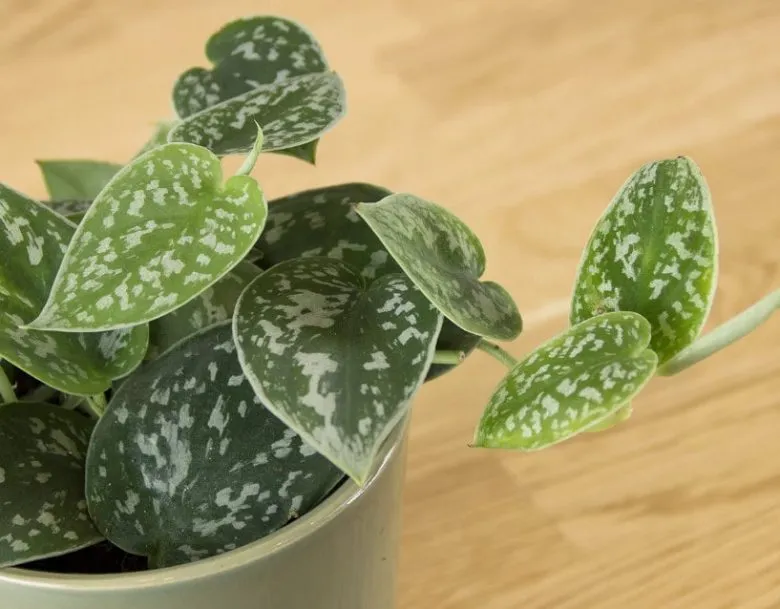
Scindapsus pictus Argyraeus
For a successful cultivation of the plant of scindapsus pictus at home, it is important to provide the right environmental conditions.
Scindapsus prefer indirect or filtered light. Avoid direct exposure to strong sunlight, as it may cause burns on the leaves. Then place the plant near bright windows, but make sure it is not exposed to direct sunlight.
This plant does well in moderate temperatures. The ideal temperature for it scindapsus pictus it is between 18 °C and 27 °C. Avoid sudden changes in temperature and place the plant away from heat sources such as radiators or fireplaces.
This plant appreciates moderate relative humidity. If the air in your home is particularly dry, you can increase the humidity by placing the plant on a tray with moist pebbles or using a humidifier. However, avoid excess moisture, which could cause problems such as mold or root rot.
What is the land suitable for cultivation scindapsus pictus?
For growing a plant of scindapsus pictus in pots, it is advisable to use a well-draining soil that provides adequate moisture retention.
You can prepare a substrate mix by mixing a specific soil for indoor plants with inert material that favors drainage such as perlite (link).
As for repotting the plant, it tends to grow quite quickly. Usually, it is advisable to repot the plant every year or two, preferably in spring or early summer. If you notice that your scindapsus pictus is getting too big for the current pot or roots are starting to come out of the drainage holes, it’s a sign that it’s time to repot. When repotting, switch to a slightly larger pot to give progressive space for the developing roots.
Kif timmultiplika pjanta ta scindapsus pictus by cuttings?
To multiply a plant of scindapsus pictus hemm the simplest technique is that of cutting.
To make this, take a healthy cutting of about 15-20cm from the mother plant, making sure the cutting has at least 2-3 nodes, where the nodes are where the leaves grow from. Cut the cutting just below a lower node and remove any lower leaves to expose the node.
Now plant the cutting in well-draining soil and keep the cutting in a warm, humid environment, for example by covering it with a clear plastic bag or using a mini greenhouse. This will help keep the humidity high around the cutting. Place the cutting in an area with indirect light and avoid direct exposure to the sun. After a few weeks, the cutting should root. You can verify rooting by lightly tugging on the cutting to feel its resistance. Once the cutting has put out strong roots, you can transplant it into a larger pot and continue with its normal care.
Kemm ilma biex tagħti scindapsus pictus?
il scindapsus pictus it requires proper watering management to ensure healthy growth.
Before watering the plant, always check the soil. Insert a finger into the substrate about 2-3 cm deep. If the surface soil is still damp, wait a few days before watering again. Be sure to avoid excess standing water, which could cause root rot.
The plant prefers slightly moist, but never soggy soil. When you water, be sure to wet the soil evenly until water begins to seep out of the pot’s drainage holes. This will help ensure that the soil is well hydrated.
Take into account the seasons and environmental conditions, even inside houses. During summer or hotter times, it may need to be watered more frequently due to faster water evaporation. During the winter or in colder environments, watering frequency may decrease.
Observe the plant carefully and adjust the watering according to its specific needs. Remember that it is always better to slightly underwater than to overwater the plant.
Kif fertilize pjanta Scindapsus?
Fertilizing is important to provide the necessary nutrients for the plant scindapsus pictus for healthy growth.
In general, you can fertilize scindapsus once a month during the active growing season, which is usually spring through summer. During the autumn-winter months, when the plant is in a state of rest, you can reduce the frequency of fertilization to every two or three months.
Use a balanced and dilutable organic liquid fertilizer, hawn għandek issib għażla. Carefully follow the manufacturer’s instructions regarding the amount and dilution of the fertilizer. Avoid applying fertilizer directly to the leaves to avoid burns or damage.
How to prune it scindapsus pictus?
il scindapsus pictus it does not require regular pruning, but can occasionally benefit from a light pruning to control its shape or promote denser growth. Remove any dry, yellowed or damaged leaves. This will promote a better aesthetic and keep the plant healthy.
If the vines become too long or untidy, you can opt for a light pruning to reduce their length. Cut the stem above a healthy node to promote new lateral growth. Also, if you want a denser plant, you can stimulate branching by shortening the stems. This will encourage the development of new shoots and a denser appearance.
Ftakar tuża imqassijiet taż-żbir nodfa u li jaqtgħu to avoid damage to the plant. Also, it is important to pay attention to the amount of pruning performed, as excessive pruning could weaken the plant.
Because the leaves of the scindapsus pictus do they turn yellow?
Il - weraq tal - scindapsus pictus they can turn yellow for various reasons.
For example, excessive watering can lead to water stagnation in the soil, causing root rot. Damaged roots will not be able to absorb nutrients properly, causing progressive yellowing of the leaves. Make sure you only water the plant when the topsoil feels dry to the touch and that the pot has a good drainage system.
Conversely, if the soil gets too dry, the leaves can turn yellow and wither. So make sure you maintain an adequate level of hydration for the plant.
Another problem can be related to insufficient or excessive light. As said it scindapsus pictus prefer indirect light or filtered light. Direct exposure to intense sun can cause burns on the leaves, while insufficient light can weaken the plant and lead to yellowing of the leaves. Place the plant in a well-lit area, but avoid direct sun exposure.
Finally, the preferred temperatures are moderate, between 18 °C and 27 °C. Extreme temperatures, such as severe cold or excessive heat, can adversely affect the plant and cause yellowing of the leaves.
How to polish the leaves?
Il - weraq tal - scindapsus pictus they do not require polishing. The leaves of the pictus plant have a naturally velvety and lustrous surface and their beauty can be appreciated without the need for additional polishing.
From time to time, you can gently wipe the scindapsus leaves with a soft, damp cloth or feather duster to remove any dust that has accumulated on the surface. Avoid using chemicals or cleaners on the plant, as they could damage the leaves.
Avoid excessive handling and rubbing, as you may risk damaging the leaves and removing their characteristic velvety coating.
What are the parasites that can attack it scindapsus pictus?
il scindapsus pictus it can be subject to the attack of some common parasites. Here are some of the main pests that can infest this plant:
- afidi: Small, soft-bodied insects that feed on plant sap. They can cause damage to the leaves, deformation and general wilting of the plant. At the first signs of infestation intervene with a trattament b'sapun tal-potassju artab;
- dud tal-brimba aħmar: the mite known as red spider mite is a microscopic parasite that can infest the leaves of the scindapsus pictus. These mites feed on plant juices and can cause leaf spotting or yellowing, as well as severe dieback. To eliminate the red spider mites it is necessary to increase the humidity of the vegetation, spraying fresh water directly on the leaves;
- insetti tal-iskala: Mealybugs are small, flattened insects that attach themselves to the leaves and stems of plants. They suck sap and can cause yellowing, warping, a sticky appearance, and the formation of nugrufun on the surface of the leaves. At the first signs of infestation intervene with a treatment based on white oil.
What are the fungal diseases to which it is subject?
il scindapsus pictus it can suffer the onset of various fungal diseases.
Hawn huma l-aktar komuni:
- root rot (Pythium spp., Rhizoctonia spp.): these fungal diseases are caused by soil fungi that attack the roots of the scindapsus pictus. They are manifested by root rot, poor root development and general wilting of the plant. Excessive soil moisture can favor the development of these diseases;
- leaf rot (Botrytis cinerea): this fungus causes a gray mold on the leaves of the tree scindapsus pictus. It develops in conditions of high humidity and poor air circulation. It can cause dark spots on the leaves, rot and general leaf deterioration;
- powdery mildew or white mold: this fungal disease manifests itself with a whitish or grayish patina on the leaves of the scindapsus pictus. It often occurs in rooms with high humidity and poor ventilation. May cause leaf spoilage, reduced vitality and overall plant appearance.
To prevent or manage these fungal diseases, it’s important to provide good air circulation around the plant, avoid overwatering, and make sure the soil is well drained. Additionally, removing and destroying infected plant parts can help contain the spread of disease.
il scindapsus pictus is it toxic?
il scindapsus pictus hija kkunsidrata tossiku għall-annimali domestiċi, such as dogs and cats, as well as for humans, if ingested. The leaves and stems of the plant contain calcium oxalate crystals, which can cause irritation and burning when chewed or ingested. Therefore, it is important to take precautions when handling or placing this plant in rooms where it may be accessible to children or pets.
After handling the plant, always wash your hands with soap and water to remove any remaining sap or leaf juice. In case of direct contact with eyes or mouth, rinse immediately with water.
If you accidentally ingest the plant or have an allergic reaction, seek medical or veterinary assistance immediately, and bring along a sample or photo of the plant to aid in an accurate diagnosis.

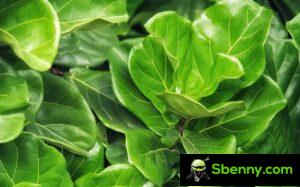
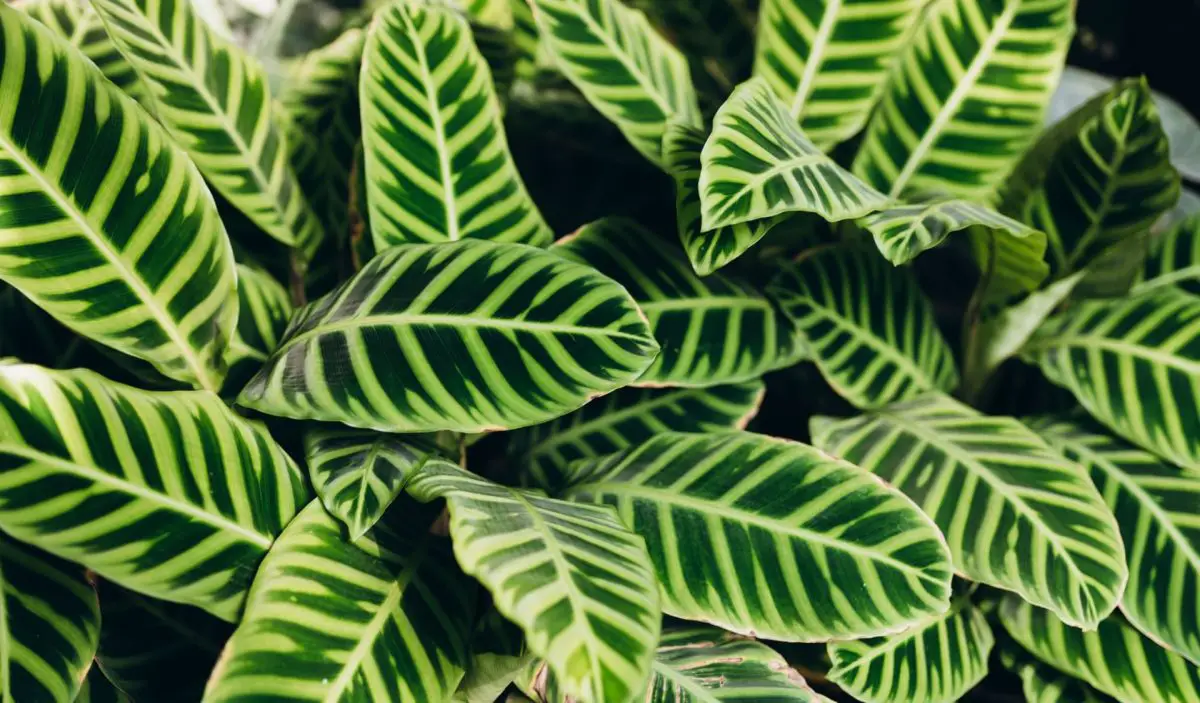
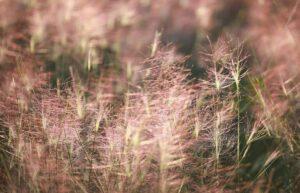
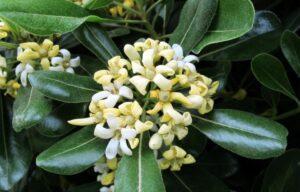
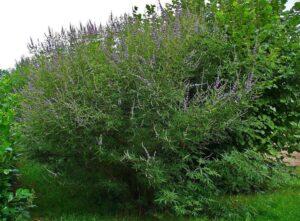
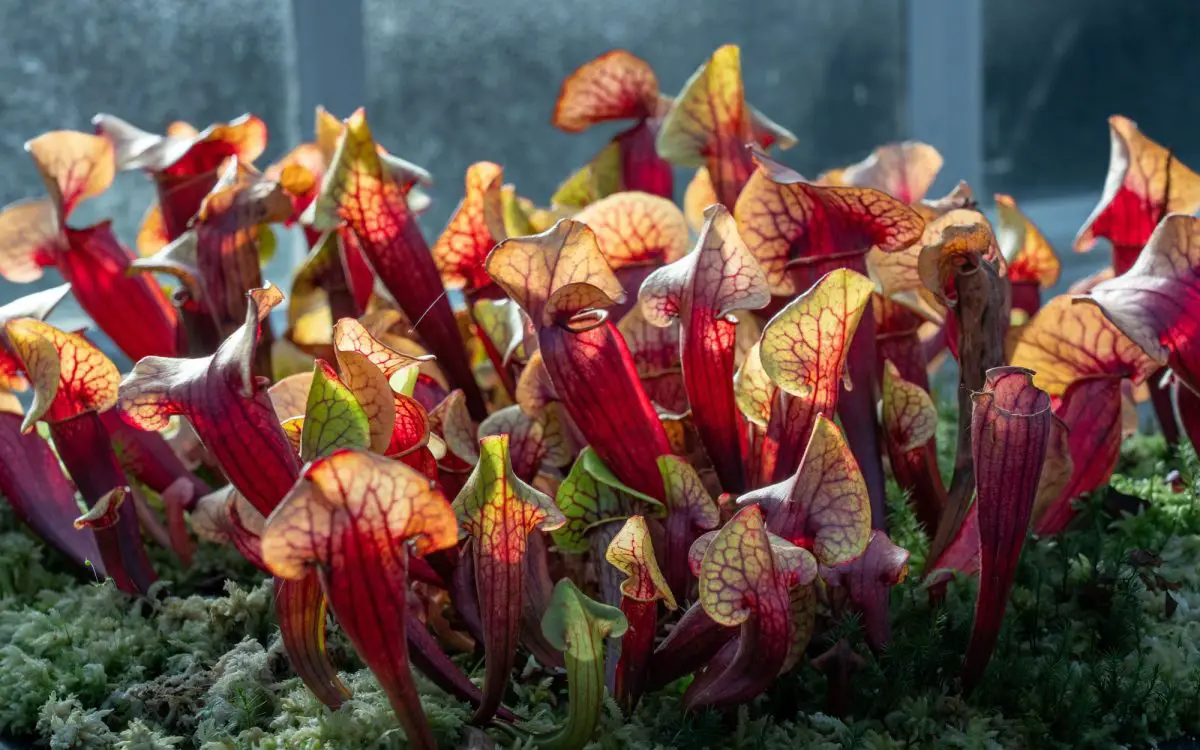
Ibda Thread ġdid